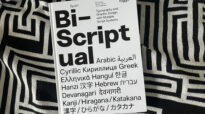Q&A with DesignThinkers Speaker Eleni Beveratou
Interview with
2023 Speaker Eleni Beveratou received a plethora of questions from the audience at DesignThinkers Toronto. Below, she answers it all!
What kinds of cultural aspects do you take into consideration with your projects?
At Dalton Maag, we specialize in creating typefaces for a diverse range of writing systems, which is a distinct aspect of our work. As a Greek individual, I am always delighted when a typeface extends beyond Latin characters, as it means that I will have more options to choose from.
However, creating a typeface has many cultural considerations, especially when it involves multiple writing systems. Alongside proportions, design features and weight matching, many typographic terms that are common in the Latin writing system, such as Uppercase, Serifs and Italics, may not translate directly to other scripts. This requires a deep understanding of the expectations of users of each writing system, emphasizing the end user's preferences over our Latin-informed perspective.
Furthermore, many writing systems serve multiple languages across different regions, introducing regional preferences. These must be thoughtfully adapted to reflect the rich diversity within languages that share the same writing system.
Any suggestions for how to approach designing a variable font?
The approach to designing a variable font largely depends on the axes involved. For a weight axis, I recommend starting by drawing 7-8 key characters in the Regular weight. Once the design direction is established, I would then extrapolate to the heaviest and lightest weights of this variable font. After completing those, I would re-interpolate the regular weight and refine it. A similar process would be followed for a width axis. For a slant axis or something more unconventional, it’s advisable to focus on drawing the extremes first and consistently checking what happens between them to ensure that the transformation is smooth and as expected.
How do you decide a minimum requirement for glyph sets for an accessible typeface?
The accessibility of a typeface extends beyond letter design to include aspects like spacing. It’s not just a checklist, but rather a range of features that enhance accessibility. Depending on the design direction, various components are necessary for an accessible outcome.
Generally, lowercase letters are more accessible than uppercase due to the latter's repetitive shapes (e.g. the tops of H, U, I, L), which can cause ambiguity. Lowercase letters, with their more distinct forms, facilitate faster reading comprehension. Horizontal and vertical proportions are critical, as is minimizing ambiguity between characters that can appear similar, such as I, l and 1 or O and 0. Also, prioritizing readability of frequently used characters is essential. For example, a double-storey 'a' is typically more accessible than a single-storey 'a' which can be easily confused with q, g or o.
Have you designed any type for signage?
Yes, we have. Our font library includes Calmetta, a contemporary humanist sans typeface with a generous x-height, designed specifically for grid-based signage and wayfinding. Other typefaces, including Venn, Stroudley, Setimo and Darkmode are also crafted for exceptional accessibility, making them suitable for wayfinding.
We have also had the honour of developing custom typefaces for urban wayfinding, including projects in Southampton and Vienna, as well as for San Francisco Airport.
How can we convince clients it's okay to use ligatures?
Ligatures are an excellent OpenType feature, but require judicious use. There are standard ligatures, like fi and fl and discretionary ones, such as st. The latter are more suitable for display purposes, enhancing aesthetics in logos and titles or emulating natural letter connections in handwritten fonts.
For standard ligatures, their appropriateness varies by medium. They are recommended for long-form text in printed or digital media. However, in UI environments, overly connected letters might be distracting. In such cases, a modified design where letters like 'f' and 'i' are closer without touching, can be beneficial, improving consistency without affecting legibility.
Do you think AI will start making typefaces?
AI has already begun creating typefaces, but its success in the field remains a topic of debate. The creation of high-quality typefaces currently involves extensive human interaction, problem-solving and testing that go far beyond instructions to a tool.
AI may accelerate the font creation process, which might be extremely beneficial for some writing systems, but human expertise remains crucial. This ensures that typefaces are not only aesthetically pleasing but also functional, accessible and culturally sensitive.
Tag
Related Articles


Jumanah Abualkhair Associate RGD, Michael J. Young RGD














